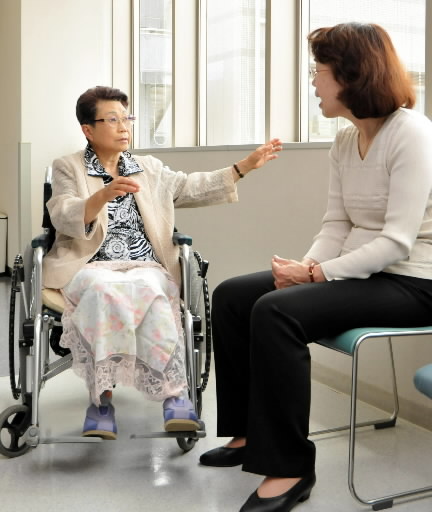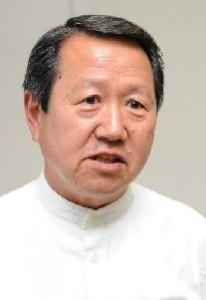How can care be provided to patients outside the city?
May 21, 2011
Hiroshima assigns counselor for A-bomb microcephaly patients
by Sakiko Masuda, Staff Writer
Those who have been designated by the central government as sufferers of A-bomb microcephaly were exposed to the atomic bomb while still in the womb and have lived with the effects of radiation. Sixty-six years have passed since the dropping of the atomic bomb on Hiroshima. The microcephaly patients and the family members who offer support to them are aging. In April the City of Hiroshima assigned a medical social worker to provide counseling to the patients. The Ministry of Health, Labor and Welfare is providing a subsidy, but the program is administered by the city. There are 22 A-bomb microcephaly patients in Japan. In order to provide medical care and welfare services suited to their circumstances, a support system for which the central government will assume responsibility is needed.
Sending counselor to other areas difficult
Consultations to be conducted by phone
Central government-based system essential
On May 7, the Mushroom Club, a group of 18 microcephaly patients and their families, held its general meeting at a city facility in Hiroshima’s Minami Ward. Yurie Kawamiya, 55, who will serve as the counselor for the patients, attended the meeting and talked with them for the first time. Ms. Kawamiya is also head of the Hiroshima Prefecture Association of Medical Social Workers.
“I want to live peacefully. That’s my most fervent desire,” said Kimie Kishi, 65, who came from Miyoshi in northern Hiroshima Prefecture to attend the meeting and spoke earnestly with Ms. Kawamiya.
Ms. Kishi’s mother, Shizuyo Doi, was exposed to the atomic bomb at their home 1.2 km from the hypocenter when she was three months pregnant. Ms. Kishi’s 44-year-old father, Katsuichi, who had joined a civil defense unit, was killed.
Trapped under the ruins of their home, Shizuyo was later rescued and returned to her hometown of Miyoshi where she gave birth to her daughter. From a young age Ms. Kishi suffered from pain in her hips and other symptoms typical of microcephaly. She stopped growing when she reached a height of 138 cm.
When Ms. Kishi was 24 she married her husband, whom she had met in a hospital she was staying in. They had a son and a daughter. Ms. Kishi’s husband died in 1992 at the age of 53, and her mother, on whom she had depended, died in 2002 at 94. Ms. Kishi lost her two older sisters in 2006.
Handle difference in systems by sharing information
Ms. Kishi said she continues to live alone because her children have their own lives and she doesn’t want to be a burden on them. Her hips have worsened over the years, and she must use a cane even when walking indoors. “My legs hurt, and I can’t take a bath by myself,” she said.
After her talk with Ms. Kawamiya, Ms. Kishi said, “I’m glad I had a chance to speak with her directly.” But she added that she still felt somewhat unsettled because, while the 10 patients who live in Hiroshima City may visit the counselor for consultations as needed, those like Ms. Kishi who live outside the city must either go to Hiroshima’s Atomic Bomb Survivors Relief Department, where the counselor works, or consult with her by telephone.
With regard to the difference in support provided to those who live in Hiroshima City and those who reside in other areas, the Health Service Bureau of the Ministry of Health, Labor and Welfare, which is in charge of support for atomic bomb survivors, has said that it will create a network between the City of Hiroshima and the municipalities in which the other A-bomb microcephaly patients live. When this project gets underway, the ministry has said it will prepare a list of the names of the employees who will be in charge of this issue as well as public health nurses in the cities of Hiroshima and Nagasaki and in seven prefectures. The ministry has said that support will be provided by sharing this information.
A 65-year-old microcephaly patient who lives in Osaka and is now hospitalized expressed concern, however, saying, “Unlike Hiroshima, city officials here have little understanding of issues related to the atomic bombing. Even if I consult with them, I don’t know whether or not they will be sympathetic.”
Akimi Nakamura, manager of the Relief Section of the City of Hiroshima’s Atomic Bomb Survivors Relief Department, said, “If we are contacted by patients who live outside the city or their families, we will contact the municipality where they reside and handle the matter as seriously as we would that of someone living in Hiroshima.” But he added that under the current system it would be difficult to send the counselor to another municipality as a city service.
Training for those in charge
What measures are necessary to bridge the gap between those who live in Hiroshima and those who don’t? Sugako Murakami, 65, a professor at Hyogo University who conducts research on medical workers, provides support to the Mushroom Club. She has proposed that those in charge of microcephaly-related issues in each municipality get together for training.
“We must consider the microcephaly patients’ overall medical care and welfare services from the standpoint of their status as atomic bomb survivors, as disabled people and as senior citizens and provide support for the entire family,” Murakami said. “The information and know-how that the Mushroom Club and the City of Hiroshima have should be put to good use.”
The Mushroom Club regards the assignment of the counselor as a major step forward. Naomasa Hirao, 47, the group’s executive director, said, “The microcephaly patients were harmed before they were born as a result of the war that the government started, and their family ties were broken. The government has a responsibility to compensate them.”
If the government plays a central role, the counseling program will give patients the assurance that they can get support no matter where they are. The Mushroom Club will continue to call for the establishment of a comprehensive support system.
An interview with Yoshio Nagaoka, president of the Mushroom Club
Desire for support appropriate to the circumstances
Yoshio Nagaoka, 62, is president of the Mushroom Club. His 65-year-old brother is a microcephaly sufferer. The Chugoku Shimbun asked him about his impressions of the new counseling program and his specific desires for support. The following are excerpts from that interview.
Of the 18 members of the Mushroom Club only two have parents who are living. Insofar as we have been able to determine, six patients live with their mothers or siblings. Four of them live on their own but receive support from siblings, and four are living in institutions. Two are hospitalized. Some patients have no contact with their relatives and lead lonely lives.
So I have high hopes for the counselor who has been assigned to the Hiroshima City Office. She is a medical social worker with a lot of experience. If possible I’d like her to be assigned to the municipal hospital where she can offer counseling while maintaining close contact with the hospital’s medical departments.
The Ministry of Health, Labor and Welfare is pursuing the creation of a network between the municipalities the patients live in. I’d like to see them make that work effectively. Some of the patients have mental as well as physical handicaps. With each passing year it becomes more difficult for them to live independently. I’d like the ministry to set up a system by which patients and their families who live outside the city can also meet directly with the counselor to get advice.
The families have suffered unfair prejudice as the result of having a member who experienced the atomic bombing and suffers from a handicap as a result. That doesn’t mean we can just leave matters as they stand. They may have feelings about this that they can’t talk about openly. There are also problems that can’t be solved by the family alone. I’m also worried that support may not be reaching patients who are not members of the Mushroom Club.
Each of the patient’s symptoms and living conditions are different. By rights the government should interview all of the patients and their families throughout Japan in order to get a grasp of the situation. I would like the government to provide support appropriate to their circumstances, not just perfunctory care.
Profile: Yoshio Nagaoka
President of the Mushroom Club since 2009. His mother, the late Chizuno Nagaoka, also served as the group’s president. Resident of Asa Minami Ward, Hiroshima City.
Keywords
A-bomb microcephaly
Some unborn babies that were exposed to a heavy dose of radiation near the hypocenter of the atomic bombing early in the pregnancy were born with microcephaly. The circumference of their heads is smaller than normal, and they may also suffer from mental and physical handicaps. According to the Ministry of Health, Labor and Welfare, there are currently 22 A-bomb microcephaly patients in Japan. Thirteen of them reside in Hiroshima Prefecture with 10 of those in the city of Hiroshima. Of the others, three live in Nagasaki Prefecture, including two in the city of Nagasaki. There are two patients in Osaka and one each in Yamaguchi, Tokyo, Kanagawa and Fukuoka prefectures. The Mushroom Club, established in 1965, is now composed of 18 microcephaly patients, nine men and nine women, their families and other supporters.
(Originally published on May 16, 2011)









